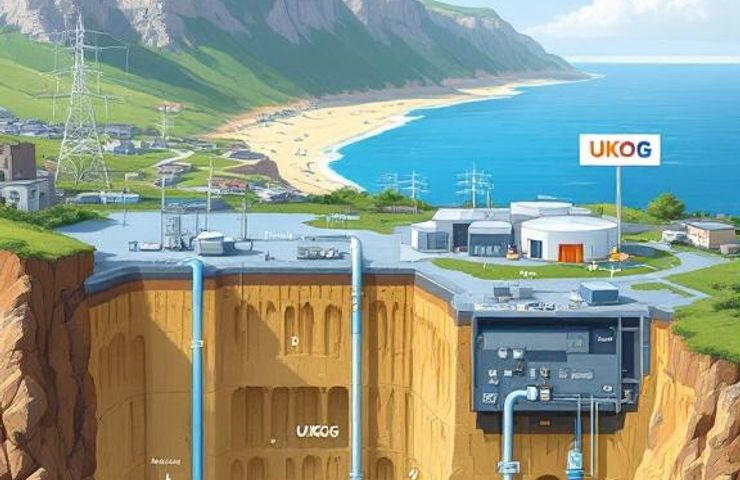
UKOG Turbocharges Hydrogen Storage Strategy with £0.52M Injection
November 25, 2025UK Oil & Gas PLC just ploughed another £0.52 million into its hydrogen ambitions—taking total fresh capital past £5 million since October. Hold on, before you write this off as small-cap green cheerleading, remember that salt-cavern hydrogen storage can run into the hundreds of millions. That half-million quid? It’s just the amuse-bouche, not the main course.
Since 2023, UKOG has been juggling investor activists and tighter regs, shifting from oil and gas exploration to clean energy. Their hydrogen pivot, driven by wholly owned arm UK Energy Storage (UKEn), is now the company’s lifeline. The UK government’s hydrogen strategy puts storage on equal footing with production—essentially spotlighting whoever can move at warp speed.
Funding the Pivot
On 21 November 2025, UKOG secured another £0.52M for UKEn—its fourth equity or grant-style top-up this quarter. That lifts total funding since October north of £5M, covering technical and economic analyses, environmental impact assessments, community consultations, and early aquifer testing plus brine treatment planning. For context, building salt-cavern hydrogen storage capex easily hits the hundreds of millions, so think of this tranche as the groundwork—and a sign that investors still bet on them. UKOG says these injections blend equity placements with potential grants, hinting at growing government interest.
UKEn’s roadmap pins down Front-End Engineering and Design (FEED) by Q3 2026, aiming for a Final Investment Decision (FID) in early 2027. It’s an aggressive timetable given the need for detailed geotechnical surveys, cavity assurance tests, and permits for brine disposal without breaching environmental thresholds.
Why It Matters
Batteries can handle daily grid swings but struggle when you need seasonal storage. Salt-cavern hydrogen storage solves that, locking away gigawatt-hours of renewable juice for months. Meanwhile, heavy industries like steel, cement and chemicals could cut up to 70% of CO₂ by swapping natural gas for hydrogen—now that’s industrial decarbonization in action, turning UKEn’s caverns into a linchpin for national clean energy.
Energy security’s the other piece of the puzzle: relying on imported gas leaves the UK exposed to price shocks. Local hydrogen reservoirs offer real resilience—imagine tapping into underground stores during a cold snap or a stressed grid moment. And as the UK’s hydrogen infrastructure takes shape, these caverns become a bedrock for energy stability.
Under the Hood: Salt Caverns & Electrolysis
Building a salt cavern is part science, part craft: pump water down to dissolve thick salt layers, haul out the brine, and you’re left with a sturdy hollow ready for high-pressure hydrogen. UKEn is modeling cavern cycling at 40–200 bar, targeting injection and withdrawal rates of around 4,000 kg H₂/day. Rock-mechanics simulations and well-casing material reviews are in full swing to keep everything safe and leak-proof.
On the production side, UKOG has greenlit pre-FEED studies for a 5–10 MW electrolyzer. They’re weighing alkaline versus PEM stacks, supplier lead times, efficiency trade-offs, and grid-tie contracts—likely with offshore wind farms. Purity specs are under scrutiny: the hydrogen must meet pipeline and storage standards to avoid corrosion or blockages. This green hydrogen via electrolysis is central to their supply chain strategy.
Strategic Partnerships & Policy Choreography
UKEn’s not going solo: it’s inked a pipeline tie with a second regional operator in South Dorset and is deep in talks with National Gas for Yorkshire storage, aiming to plug into the national network via Project Union. National Gas’s own blending trials suggest they’re ready for full-scale, low-carbon operations. Rumor has it there’s a 50-year access agreement on the table, though the fine print is under wraps.
The looming Hydrogen Transport and Storage Business Model, due in late spring 2026, mirrors the offshore wind CfD by offering up to 15 years of price support. But it’s a high-stakes game: only developers with bulletproof FEED packages, confirmed offtake commitments, and clear land and water permits will secure contracts. For UKOG, the latest £0.52M is basically their auction ticket.
The Maverick Take
I’ll give them props for the hustle, but let’s keep it real: this is a capital-intensive gamble. Right now, UKOG’s cash covers studies, not cavern construction. Local pushback over brine disposal and water use could slow permits to a crawl. Government support is vital, yet this dance floor’s crowded. Unless UKOG locks in a heavyweight partner—think infrastructure funds or energy majors—they risk dilution or derailment.
Still, small caps can outflank big utilities when they stay nimble. Hit your milestones, nail down policy contracts, and suddenly you’re not just another oil driller—you’re laying the groundwork for the UK’s hydrogen backbone. And first movers often grab the spoils.
That said, cash burn is real: these studies and land leases chew up money fast. If sentiment turns sour, UKOG may need to dilute equity or chase debt—no small feat for a sub-£100M market cap.
Looking Ahead
Key checkpoints on the horizon: Dorset planning consent by mid-2026, Yorkshire cavity tests, FEED submission, and spring 2026’s subsidy auction. Nail FID in early 2027, and pump-inject cycles could kick off by 2029, syncing with UKOG’s 2030 target for the UK’s first salt-cavern hydrogen site. Miss one of those beats, though, and you’re back to drilling oil.
Investor roadshows in late 2026 will pit UKOG against deeper-pocketed rivals like Equinor and Cadent. A strong auction result could open the taps for follow-on capital; a miss might crater the share price.
About the Company: UK Oil & Gas PLC (UKOG) is a UK energy firm that’s pivoted from southern England oil exploration to green hydrogen storage and production via subsidiary UK Energy Storage (UKEn). UKEn’s projects include salt-cavern schemes in South Dorset and Yorkshire, targeting integration with the national hydrogen infrastructure through partnerships with National Gas and regional pipeline operators.


 With over 15 years of reporting hydrogen news, we are your premier source for the latest updates and insights in hydrogen and renewable energy.
With over 15 years of reporting hydrogen news, we are your premier source for the latest updates and insights in hydrogen and renewable energy.